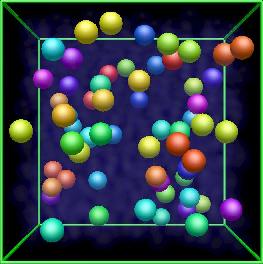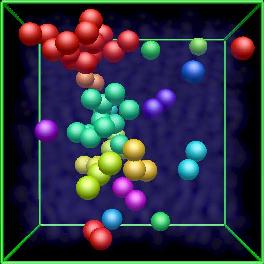


Next:About
this document ...
The Cooperative
Nature of Molecular Motion in Soft Matter: Finding Order in Disorder
Sharon
C. Glotzer, National Institute of Standards and Technology
Soft materials and
complex fluids exhibit novel properties that depend upon the degree and
type of order present. Computer simulations have provided a wealth of information
on these systems that elucidates phenomena, guides experimental investigation,
and leads directly to new theories for soft matter. Molecular dynamics
(MD) computer simulation in particular provides a unique window into the
complex microscopic processes and ordering phenomena that control the properties
and behavior of soft matter. As one example, we describe how MD simulations
have uncovered the cooperative processes that give rise to novel ordering
in liquids as they form glasses.
In dense atomic, molecular
and polymeric fluids at low temperature, and in colloidal suspensions at
high density, viscosity increases by many orders of magnitude over a narrow
temperature or density range, and classical relations between transport
coefficients break down. Our MD simulations have shown that underlying
these phenomena are dynamics that become increasingly cooperative [1] and
spatially heterogeneous [2] over a characteristic length scale which grows
rapidly as the glass transition is approached, despite the fact that density
and composition correlations remain short-ranged [3-8].

 MD simulation of a dense model glass-forming liquid showing the fastest
5% of particles in a given time frame when the liquid is (a) far from the
glass transition and (b) closer to the glass transition. In both
cases, fast particles that are immediately next to each other, and are
thus contained within the same "cluster", are shown by the same color.
MD simulation of a dense model glass-forming liquid showing the fastest
5% of particles in a given time frame when the liquid is (a) far from the
glass transition and (b) closer to the glass transition. In both
cases, fast particles that are immediately next to each other, and are
thus contained within the same "cluster", are shown by the same color.
One of the most striking
predictions of our simulations is the emergence of a highly mobile subset
of particles that move in "strings" and form ramified clusters which grow
on cooling [3,4]. These ordered  structures
have now been directly observed in confocal microscopy experiments on colloidal
liquids which form glasses at high density [9-12]. Based on the simulations,
we have developed a statistical mechanical framework that allows us to
quantify cooperative motion [5-8] and relate it to the decoupling of structural
relaxation and particle transport [8].
structures
have now been directly observed in confocal microscopy experiments on colloidal
liquids which form glasses at high density [9-12]. Based on the simulations,
we have developed a statistical mechanical framework that allows us to
quantify cooperative motion [5-8] and relate it to the decoupling of structural
relaxation and particle transport [8].
In this talk, we describe
this novel type of order that emerges in disordered systems, and demonstrate
the unique role of simulation as a tool to identify the relevant quantities
to measure. We outline open questions, and discuss the potential relevance
of this work to applications ranging from information technology, food
processing and sporting goods to nanotechnology. Through this example,
we illustrate challenges and future directions in computational materials
science of soft matter.
[1] G. Adam and J. H. Gibbs, J. Chem. Phys. 43, 139 (1965).
[2] See reviews by H. Sillescu, J. Non-Cryst. Sol. 243, 81 (1999);
R. Bohmer, Current Opinion Solid State Mater. Sci. 3, 378 (1998);
M. D. Ediger, Annu. Rev. Phys. Chem., July 2000; S.C. Glotzer, J. Non-Cryst.
Solids, in press.
[3] C.
Donati, J.F. Douglas, W. Kob, S.J. Plimpton, P.H. Poole and S.C. Glotzer,
Phys. Rev. Lett. 80, 2338 (1998).
[4] C.
Donati, S.C. Glotzer, P.H. Poole, W. Kob and S.J. Plimpton, Phys. Rev.
E 60, 3107 (1999).
[5] C.
Donati, S.C. Glotzer and P.H. Poole, Phys. Rev. Lett. 82, 5064 (1999).
[6] C.
Bennemann, C. Donati, J. Baschnagel, and S.C. Glotzer, Nature
399,
246 (1999).
[7] P.
Ball, Nature 399, 207 (1999).
[8] S.C.
Glotzer, V. Novikov and T.B. Schroeder, J. Chem. Phys. 112, 509
(2000).
[9] W.
Kegel and A. van Blaaderen, Science 287, 5451 (2000).
[10] E.
Weeks, J.C. Crocker, A.C. Levitt, A. Schofield, and D.A. Weitz, Science
287, 627 (2000).
[11] P. Weiss,
Science News, ``In glass, fast crowds boogie to brittle end,'' January
29, 2000.
[12] S. C. Glotzer,
Physics World, 13, 22, 2000.



Next:About
this document ...
Sharon Glotzer 2000-07-09

 MD simulation of a dense model glass-forming liquid showing the fastest
5% of particles in a given time frame when the liquid is (a) far from the
glass transition and (b) closer to the glass transition. In both
cases, fast particles that are immediately next to each other, and are
thus contained within the same "cluster", are shown by the same color.
MD simulation of a dense model glass-forming liquid showing the fastest
5% of particles in a given time frame when the liquid is (a) far from the
glass transition and (b) closer to the glass transition. In both
cases, fast particles that are immediately next to each other, and are
thus contained within the same "cluster", are shown by the same color.
 structures
have now been directly observed in confocal microscopy experiments on colloidal
liquids which form glasses at high density [9-12]. Based on the simulations,
we have developed a statistical mechanical framework that allows us to
quantify cooperative motion [5-8] and relate it to the decoupling of structural
relaxation and particle transport [8].
structures
have now been directly observed in confocal microscopy experiments on colloidal
liquids which form glasses at high density [9-12]. Based on the simulations,
we have developed a statistical mechanical framework that allows us to
quantify cooperative motion [5-8] and relate it to the decoupling of structural
relaxation and particle transport [8].